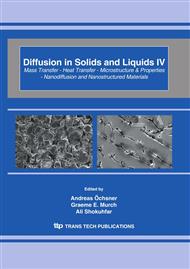p.65
p.74
p.84
p.90
p.98
p.106
p.111
p.117
p.123
Effect of Polymeric Milling Media on the Mechanosynthesis and Structural Properties of Nanocrystalline Hydroxyapatite
Abstract:
Mechanochemical process in polymeric vials has been carried out successfully to produce nanocrystalline hydroxyapatite (HAp) through two different reactions R1 and R2. Morphological properties and structural evaluation of obtained materials are studied by X-ray diffraction (XRD), scanning and transmission electron microscopy (SEM and TEM). The obtained data show that the increase in milling time leads the increasing in lattice strain and decreasing in crystallite size. The average crystallite size of HAp is below 20 and 23 nm for R1 and R2 reactions, respectively. Based on XRD patterns and SEM/TEM micrographs, the possible formation mechanism of nanocrystalline hydroxyapatite by mechanochemical process in polymeric milling media is confirmed. Final results indicate that the nanocrystalline hydroxyapatite with low chemically stable contaminations and suitable morphology can be produced in Polyamide6 vials similar to stainless steel vials, therefore it seems that using polymeric vials could lead to a new way for the mass production of nanocrystalline hydroxyapatite with high performance, low contamination and cost and also suitable morphology.
Info:
Periodical:
Pages:
98-105
Citation:
Online since:
March 2009
Keywords:
Price:
Сopyright:
© 2009 Trans Tech Publications Ltd. All Rights Reserved
Share:
Citation:


